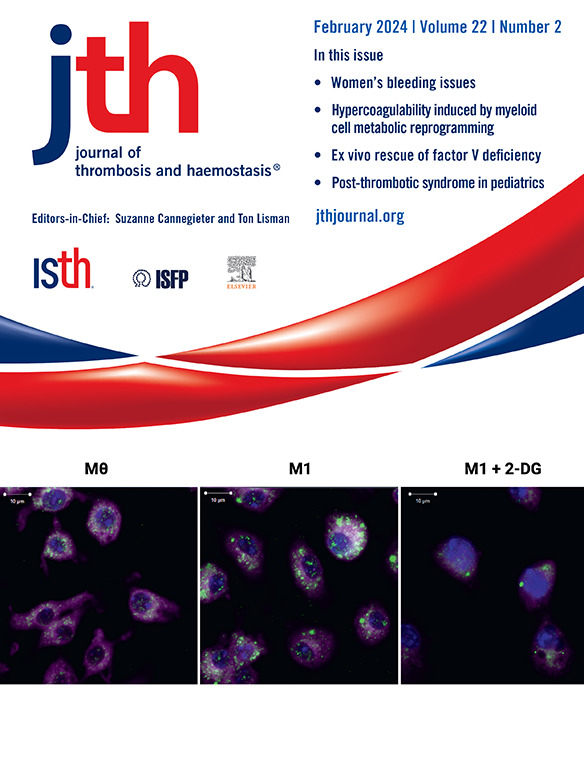唾液化糖蛋白以顺式方式与血小板上的siglece -9结合以抑制血小板活化。
IF 5.5
2区 医学
Q1 HEMATOLOGY
引用次数: 0
摘要
背景:血小板内源性负调控在预防自发性血栓形成中起重要作用,但其体内平衡机制尚不完全清楚。目的:在本研究中,我们旨在探讨siglece -9是否具有负调控作用,并鉴定血小板上siglece -9的配体。方法:采用血小板因子4-cre、siglece - eflox /flox敲除小鼠模型和人血小板体外培养系统,研究siglece -9对血小板的作用。此外,还在血小板上表达和利用了siglece -9配体的重组糖蛋白(GP)。结果:我们发现siglece条件敲除可导致体内和体外血小板凝血活性显著增加,这强烈提示siglece -9/E在血小板活化中具有抑制生理作用。siglece -9配体是一种具有α2,3链唾液酸末端结构的o链GP,该配体的蛋白质载体是GPIbα的黏液样区。我们的数据进一步表明,血小板上的配体不能通过反式结合与其他细胞上的siglece -9结合,这表明血小板上的配体发挥了自调节作用。此外,我们提供的证据表明,外源性特异性配体激活siglece -9通路可以抑制血小板的活性。这些数据证明了GPIbα在抑制血小板活化中的作用,并为血小板稳态提供了一种新的机制。结论:GPIbα黏蛋白样区与siglece -9之间的顺式结合对血小板活化起着“刹车”作用。这一发现为新型抗血小板药物提供了一个潜在的可药物靶点。本文章由计算机程序翻译,如有差异,请以英文原文为准。
Sialylated glycoproteins bind to Siglec-9 in a cis manner on platelets to suppress platelet activation
Background
The endogenous negative regulation of platelets is important in preventing spontaneous thrombosis, while the mechanism of homeostasis is incompletely understood.
Objectives
In this study, we aimed to explore whether Siglec-9 plays a negative regulative role and identify the ligand of Siglec-9 on platelets.
Methods
To determine the role of Siglec-9 on platelets, platelet factor 4-cre:Siglec-Eflox/flox knockout mouse model and human platelet in vitro culture system were used. Furthermore, recombinant glycoprotein (GP) of Siglec-9 ligand on platelets was expressed and used.
Results
We found that Siglec-E conditional knockout can lead to significant increase in platelet coagulation activities both in vivo and in vitro, which strongly suggests that Siglec-9/E plays an inhibitory physiological role in platelet activation. Siglec-9 ligand is an O-link GP with an α2,3-linked sialic acid terminal structure, and the protein carrier of the ligand is mucin-like region of GPIbα. Our data further showed that the ligands on platelets could not engage Siglec-9 on other cells via trans-binding, which indicates that the ligands on platelets play a self-modulation role. Furthermore, we provided evidence that the activation of Siglec-9 pathway with exogenous specific ligands could inhibit the activity of platelets. These data demonstrate a previously unanticipated role for GPIbα in inhibiting platelet activation and provide a novel mechanism for the homeostasis of platelets.
Conclusions
We conclude that the cis-binding between mucin-like region of GPIbα and Siglec-9 acts as a “parking brake” on platelet activation. This finding provides a potential druggable target for novel antiplatelet medicine.
求助全文
通过发布文献求助,成功后即可免费获取论文全文。
去求助
来源期刊
CiteScore
24.30
自引率
3.80%
发文量
321
审稿时长
1 months
期刊介绍:
The Journal of Thrombosis and Haemostasis (JTH) serves as the official journal of the International Society on Thrombosis and Haemostasis. It is dedicated to advancing science related to thrombosis, bleeding disorders, and vascular biology through the dissemination and exchange of information and ideas within the global research community.
Types of Publications:
The journal publishes a variety of content, including:
Original research reports
State-of-the-art reviews
Brief reports
Case reports
Invited commentaries on publications in the Journal
Forum articles
Correspondence
Announcements
Scope of Contributions:
Editors invite contributions from both fundamental and clinical domains. These include:
Basic manuscripts on blood coagulation and fibrinolysis
Studies on proteins and reactions related to thrombosis and haemostasis
Research on blood platelets and their interactions with other biological systems, such as the vessel wall, blood cells, and invading organisms
Clinical manuscripts covering various topics including venous thrombosis, arterial disease, hemophilia, bleeding disorders, and platelet diseases
Clinical manuscripts may encompass etiology, diagnostics, prognosis, prevention, and treatment strategies.

 求助内容:
求助内容: 应助结果提醒方式:
应助结果提醒方式:


